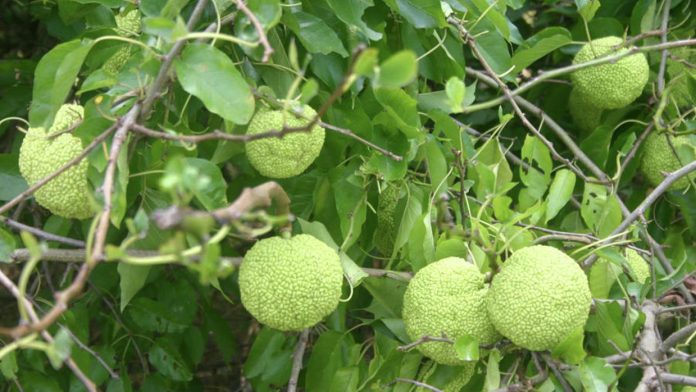One of these examples is the hedge ball or hedge apple. It has been said for many years that placing these fruits around the base of the foundation, in basement corners and in closets can repel spiders from residing in the house. For years people believed these bumpy and ugly fruits had a property to take care if this issue. After more research and study, it was found that these fruits do NOT repel insects and arachnids in any way. However, it does show that concentrated amounts of the chemical in the hedge ball will act as a repellent, but only in a laboratory setting where the substance can be extracted in quantity.
The only thing you will probably get by placing these around the house are fermenting items later in time that will have to be removed before they repel the residents!
Hedge balls or hedge apples come from the tree known as the Osage Orange. It grows in the southern Midwest in Oklahoma, Texas, Kansas and Arkansas. After traveling there this past week I was amazed at their numbers in the countryside. It is during this time of year that the fruit, often the size of a large navel orange, are dropping from the trees and littering the ground. They are lime green to yellow when ripe and have a very bumpy skin. There is very little use for the fruit as most people and animals find the flavor highly unpalatable, thus the fruit usually goes to waste.
The trees are medium in size and are oval to irregular in shape, usually reaching about 20 to 30 feet in height. They bloom in spring and need a male and female plant in order to produce the fruit. These 3- to 5-inch diameter fruits ripen in October and drop to the ground.
The wood of the Osage Orange is considered highly usable as it is very solid and hard to the core. The wood is used for furniture, fence posts and even archery bows. Many people find this to be one of the finest woods to make archery bows lending to its other name of bow-wood.
This tree is very adaptable and can grow in very poor soils, it transplants easily, it can handle drought conditions, extreme heat and strong winds. It is also resistant to most diseases and insects making it a good candidate for tree rows. Decades back, this tree use to be planted in tight rows to form a hedge. The thorny structure of the branches was used to keep in livestock when fences were costly. The fruit and branches also emit a white sappy fluid that can be irritating to the skin, so if handling any part of this tree, make sure to wear gloves.
Although referred to as Osage Orange, it is not a relative to the citrus family, but actually a member of the mulberry family.
Often we discuss plants that will grow in our area, but every once in a while, we have to explore some of the plant items we hear about but can’t necessarily grow. Osage Orange grows in zones 5—9, but is familiar to many in the plant world.
If you want to see what a hedge ball looks like, check out the local grocery store this time of year and you will find it in the produce section. Often if you can’t find it, ask for it and someone will know where it is.
Many myths have a great deal of truth to them, but in this case, the hedge ball has been researched to tell us that there is no real use for this fruit other than for possible decoration in your fall displays.
When it comes to repelling spiders, you might just try some peppermint oil as this has actually been a proven deterrent and smells pleasant to most. Keep reading about items you think are fact or myth and see what other theories you can dispel. As for the hedge ball, you can check that one off your list.





































